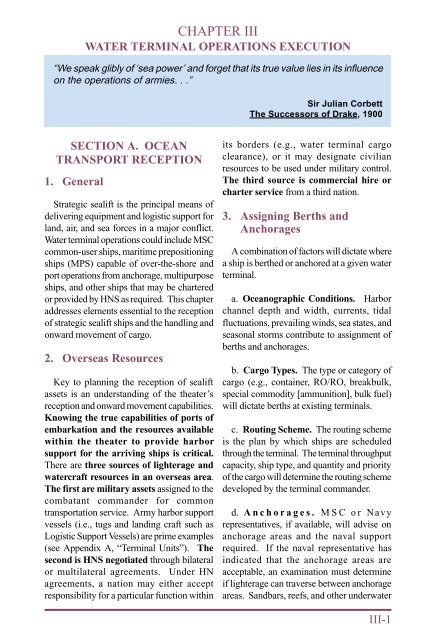JP 4-01.5 JTTP for Water Terminal Operations - BITS
JP 4-01.5 JTTP for Water Terminal Operations - BITS
JP 4-01.5 JTTP for Water Terminal Operations - BITS
Create successful ePaper yourself
Turn your PDF publications into a flip-book with our unique Google optimized e-Paper software.
CHAPTER III<br />
WATER TERMINAL OPERATIONS EXECUTION<br />
“We speak glibly of ‘sea power’ and <strong>for</strong>get that its true value lies in its influence<br />
on the operations of armies. . .”<br />
SECTION A. OCEAN<br />
TRANSPORT RECEPTION<br />
1. General<br />
Strategic sealift is the principal means of<br />
delivering equipment and logistic support <strong>for</strong><br />
land, air, and sea <strong>for</strong>ces in a major conflict.<br />
<strong>Water</strong> terminal operations could include MSC<br />
common-user ships, maritime prepositioning<br />
ships (MPS) capable of over-the-shore and<br />
port operations from anchorage, multipurpose<br />
ships, and other ships that may be chartered<br />
or provided by HNS as required. This chapter<br />
addresses elements essential to the reception<br />
of strategic sealift ships and the handling and<br />
onward movement of cargo.<br />
2. Overseas Resources<br />
Key to planning the reception of sealift<br />
assets is an understanding of the theater’s<br />
reception and onward movement capabilities.<br />
Knowing the true capabilities of ports of<br />
embarkation and the resources available<br />
within the theater to provide harbor<br />
support <strong>for</strong> the arriving ships is critical.<br />
There are three sources of lighterage and<br />
watercraft resources in an overseas area.<br />
The first are military assets assigned to the<br />
combatant commander <strong>for</strong> common<br />
transportation service. Army harbor support<br />
vessels (i.e., tugs and landing craft such as<br />
Logistic Support Vessels) are prime examples<br />
(see Appendix A, “<strong>Terminal</strong> Units”). The<br />
second is HNS negotiated through bilateral<br />
or multilateral agreements. Under HN<br />
agreements, a nation may either accept<br />
responsibility <strong>for</strong> a particular function within<br />
Sir Julian Corbett<br />
The Successors of Drake, 1900<br />
its borders (e.g., water terminal cargo<br />
clearance), or it may designate civilian<br />
resources to be used under military control.<br />
The third source is commercial hire or<br />
charter service from a third nation.<br />
3. Assigning Berths and<br />
Anchorages<br />
A combination of factors will dictate where<br />
a ship is berthed or anchored at a given water<br />
terminal.<br />
a. Oceanographic Conditions. Harbor<br />
channel depth and width, currents, tidal<br />
fluctuations, prevailing winds, sea states, and<br />
seasonal storms contribute to assignment of<br />
berths and anchorages.<br />
b. Cargo Types. The type or category of<br />
cargo (e.g., container, RO/RO, breakbulk,<br />
special commodity [ammunition], bulk fuel)<br />
will dictate berths at existing terminals.<br />
c. Routing Scheme. The routing scheme<br />
is the plan by which ships are scheduled<br />
through the terminal. The terminal throughput<br />
capacity, ship type, and quantity and priority<br />
of the cargo will determine the routing scheme<br />
developed by the terminal commander.<br />
d. Anchorages. MSC or Navy<br />
representatives, if available, will advise on<br />
anchorage areas and the naval support<br />
required. If the naval representative has<br />
indicated that the anchorage areas are<br />
acceptable, an examination must determine<br />
if lighterage can traverse between anchorage<br />
areas. Sandbars, reefs, and other underwater<br />
III-1
















